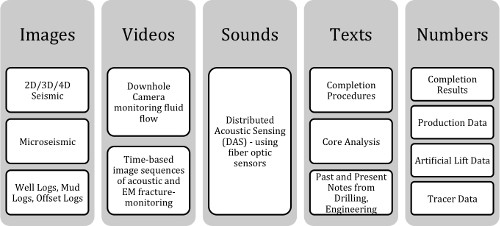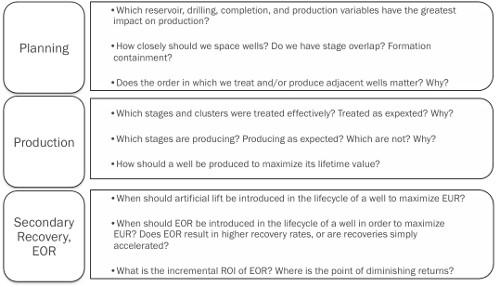Known-knowns, known-unknowns and unknown-unknowns—Donald Rumsfeld’s notable turn of phrase is an apt characterization of where we are with unconventional oil development today. Shale operators in the Eagle Ford, Permian, Bakken and other plays have transformed the U.S. into an energy superpower by profitably extracting oil and gas from tight rocks that weren’t commercially viable even a few years ago. With that backdrop, unconventional oil development today is punctuated by significant performance variations among operators with contiguous acreage positions and meager EUR rates. Unless performance keeps improving, any fluctuation in commodity prices can send shockwaves through the oil patches around the country, as we have seen happen with natural gas. How do we gain ground on the vexing “unknowns” to tilt the inherent risks involved in shale oil development in our favor?

Prescriptive analytics rely on all data types to help operators make the best decisions for their fields. (Source: Ayata)
Standing on the shoulders of giants
Geoscience—geoscientists are the giants of the energy industry—is finally getting a shot in the arm from data science, especially from Google-like technologies that are already at work in the oil patch. Leading the charge is prescriptive analytics, which can “prescribe” optimum recipes for drilling, completing and producing wells to maximize an asset’s value at every point during its operational lifetime. The premise of prescriptive analytics is to take in all data and use them to predict and prescribe how to make better wells using information from the past wells and subsurface characteristics of undrilled acreage.
While today’s sophisticated operators and energy services companies are adept at analyzing each of these datasets separately, prescriptive analytics technology is unique in that it processes these structured and unstructured datasets together and does so continually. Since reservoir conditions are anything but static, the machine learns from new streams of data and updates its “prescriptions” when the datasets signal the need for a recalibration. This adaptive environment compresses learning curves, enabling better decisions faster with less risk and much less capital.
You don’t have to know as long as your data does
Operators can start using and reaping benefits from data-driven prescriptions immediately, even if the underlying causalities are not fully understood. Think about this for a minute. We use Google to find restaurants or plan a route that avoids traffic congestion without completely understanding how or why the engine’s algorithms produced the suggestions they did. Does that lack of understanding make the results less useful? Of course not.
The same holds true for prescriptive analytics. The technology makes an immediate impact, while the geoscientists, in parallel, strive to understand the physics behind the predictions and prescriptions the software has derived from an operators’ data—lots and lots of data of all types.

Recommended Reading
Comments
Add new comment
This conversation is moderated according to Hart Energy community rules. Please read the rules before joining the discussion. If you’re experiencing any technical problems, please contact our customer care team.
